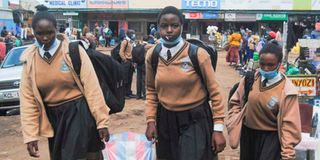Let us not sleepwalk into a learning crisis amid Covid

Elburgon Secondary School students going back to school when schools countrywide reopened for the new term in this picture taken on July 27, 2021.
What you need to know:
- It is heartening to see many countries deploy remote learning solutions during the pandemic.
- Sadly, the virtual space exposed the widening disparities between students with resources and those who lack them.
Covid-19 has been an earthquake along the already fraught fault lines of global education: 1.6 billion children were out of education at the height of school closures. If we do not act now, the young face a tsunami of looming poverty that will wipe away their future Then, we should not expect their forgiveness.
Even before the pandemic, more students were in school but this did not translate into more learning. About 53 per cent of children suffer from learning poverty — either not in school or unable to read and understand a simple story by age 10. Covid-19 could force another 10 per cent of students into learning poverty. Those in school stand to lose $10 trillion in earnings due to the learning deficit.
The pandemic contracted global gross domestic product (GDP) by 3.3 per cent last year, escalating poverty and slashing public spending on human capital. That has forced more children, especially 20 million girls, out of school forever, threatening the Sustainable Development Goal on education.
But the pandemic also offers a window of opportunity to prioritise investment in people by building resilient and equitable education systems that address learning poverty. And the benefits are clear: Investing in learning outcomes is central to building human capital, which drives productivity, prosperity and progress. Every year of schooling raises a person’s earnings by 10 per cent and boosts GDP by 18 per cent. If all adults had just two more years of schooling, 60 million people could escape poverty.
Education and innovation
So, it is heartening to see many countries deploy remote learning solutions during the pandemic. Sadly, the virtual space exposed the widening disparities between students with resources and those who lack them. Not surprisingly, a recent survey found that these solutions were difficult to use for even half of the students. We must prioritise the learning outcomes of marginalised children.
That’s not enough. We need a fundamental shift in the development finance ecosystem to help developing countries to cope with these challenges and building resilience, which is integral to the recovery and strengthening of their education systems.
To assist with this, we have developed a Universal Vulnerability Index which could transform eligibility for development finance. We must move beyond the narrow analysis of GDP and per capita income as criteria for assessing entitlement to support towards a more nuanced and comprehensive understanding of broader factors that tend to amplify vulnerability and diminish resilience.
The Global Education Summit took place this week. The world must reform measures of eligibility for access to development finance. Education and innovation are the currencies of the 21st Century with digitalisation shaping the future of work, learning, trade, cooperation and societal affairs. We must accelerate investment in the affordability of digital literacy, connectivity for schools, qualified teachers, hybrid learning solutions and online opportunities for young people based on principles of equity, inclusion and gender equality.
Ms Scotland is the Secretary-General of the Commonwealth. @PScotlandCSG





